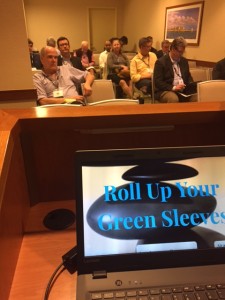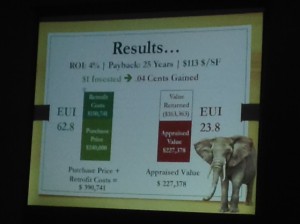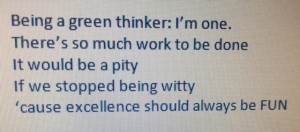My BE16 Take-aways.
 BE 16 was wonderful. The people, the ideas, the experiences, the thrill of speaking to a small but full room of engaged people, with a smart and giving co-speaker (thanks, Jim). All good. This year I did not spend a whole lot of time on the vendor floor, and perhaps I will come to regret that. I think, at least for the moment, I am a bit windowed out. I comprehend the need for innovative ERVs and non-foam insulation options, as well as the miraculous increase in well-performing tapes to help us make buildings tighter, and though all of these products and more were in sight, I walked by quickly with the purpose of refreshing my awareness. I chose not to quiz or interrogate the vendors.
BE 16 was wonderful. The people, the ideas, the experiences, the thrill of speaking to a small but full room of engaged people, with a smart and giving co-speaker (thanks, Jim). All good. This year I did not spend a whole lot of time on the vendor floor, and perhaps I will come to regret that. I think, at least for the moment, I am a bit windowed out. I comprehend the need for innovative ERVs and non-foam insulation options, as well as the miraculous increase in well-performing tapes to help us make buildings tighter, and though all of these products and more were in sight, I walked by quickly with the purpose of refreshing my awareness. I chose not to quiz or interrogate the vendors.
I felt two big trends this year in the presentations and hallway discussions: there were many larger buildings featured as case studies and examples of excellent energy-efficient achievement. Additionally, there was a strong and oft-repeated need/push for big data.
First, a general perspective – I’m starting to feel a bit like one of the old ones that has been in this work awhile and can see the trends and the gaps because of that long view back. Sigh. Luckily, this long view back gives me (us) some ability and responsibility to cultivate the long view forward. We are the continuity, and perhaps the consistent core of commitment, little distracted by the sparkly trend of the moment.
Not to undermine or dismiss the sparkly trends of the moment! Innovation and insights are tremendously needed, not only to grow the progress of this green building industry, but to shake us up and give us perspective out of the ruts we inevitably create. And the innovations will benefit from the long views to past and future as well. This is interdependence, one of the most valuable traits in sustainable practice. Back to the “big” trends.
Bigger Projects:
No conference is for all people, and I really like the practitioner and residential elements at BE16, but the lessons of superior airtightness and energy management for comfort and resiliency need to flow from and then back to the residential core of the NESEA tribe, and this is beginning to occur with conviction. It is very good to see the larger commercial and institutional projects at BE16. Kudos.
The only slightly sour note for me with some of the bigger projects is that there is still some tunnel-vision that we have to fight. For example, the Cornell project on Roosevelt Island in NYC hit so many good and appropriate notes on EE, practical limits of construction, and working with the construction team for resolutions, but I felt my question on resiliency was a real curve ball for them. We must keep many balls in play all the time. We cannot make an uber-EE building but side-line climate changes such as sea level rise and rainfall, power distribution and water wellness. We must always ask questions like “how does this energy effectiveness support health of occupants, and shelter-in-place in times of crisis?”
We also cannot allow ourselves to build buildings apart from the community and the environment we are certainly a part of…now the Roosevelt project did fine on the community piece, at least within the arena of the larger site owned by Cornell. In contrast, some of the resiliency discussions, especially those focusing on the LEED pilot credits, did not address community concerns enough. We cannot have resilient homes and commercial/institutional buildings be islands in a neighborhood that is a lost cause. It will not work. So every standard on resiliency must at least remind the user of the community elements and how strengthening the community strengthens the project’s success. Again, interdependence, anyone?
Big Data:
The other trend I mentioned was big data, which is a trend in every aspect of our lives these days: In politics, in sustainability, in purchasing, in building user engagement, in healthcare, in social media. One of the keynote speakers on day two was very clear that we are not a rationale species, but emotional. So here is my biggest question from BE16. How do we take the big data on costs, GHG emissions, NPV (net present value) for investments, traction in the marketplace, toxins in our families and…all that data, and turn it into an emotional or spiritual driver for large-scale traction? We cannot simple say we need more data. We must have a plan for the data.
We also cannot merely focus on creating more incentives as the tool for creating more traction. At this point, and from what I’ve seen working in government with copious incentive programs, the only people who make use of incentives are the ones who were already considering a project. It’s a nice helping hand, but in most cases is not the reason the project is undertaken. In commercial work, yes, incentives can certainly be a driver, but in residential work especially in the mid and lower-income ranges, not so much. In 1997, there were about 4.6 million commercial buildings and 101 million households in the USA (single family, multi-family, apartment low and high-rise, and mobile homes) (Lawrence Berkely Lab 2001 report on existing USA building stock) Commercial is big and attainable, but 101 million households – there’s a market that is as yet mostly untapped. Residential owners and renters typically do not have the expertise, time, or the interest. We need a marketing plan, designed for them. A serious plan, definitively rolled out.

Slide from “the Elephant in the Room” showing lack of clear transcendent financial reasons for residential EE.
In that same Lawrence Berkeley Labs report they determined that 38% of the construction work in the USA is renovation work. Let’s focus just on the existing residential market for this brief discussion. What is the biggest driver of renovation work in residential market? I would dare to say these projects are driven mostly by style refreshing and by change of ownership/use. There are also many house “flips” pushed by the HGTV world of reno-for-quick-buck projects, but these are a very small percentage in real life even though they are most of what we see on the networks. If we focus on the two main elements, what data do we need and what incentives could be created to max the EE and RE inclusion in the work? More importantly, how do we apply the data once we obtain it? How do we appeal to the owner and make it particularly easy and exceptionally sexy to green up while they clean up? Yes, there will be an increase in costs, so incentives can be structured to cover at least part of that increase. But what emotional driver can we find to make it dumb NOT to green up when redoing a kitchen, for example? Before you say again “incentives” make sure you understand that no one incentivized granite countertops, yet it seems everyone wants one. How do we make sustainability that appealing? What chic examples of success can entice the owner and illustrate that high comfort and excellent energy efficiency will make their roof replacement more awesomely cool when that roof is beyond its lifespan? What magazine cover photos and celebrity spokespersons can highlight the exceptional comfort and resiliency that passivhaus level work brings? What is our marketing plan? Until we figure that part out, I suspect we will be successful in our individual firms and projects and create some excellent conferences and effective one-off policies, but we will not make the permanent, sustaining change we need.
There, those are my two big reveals from BE16. It is incredibly refreshing to attend a conference that asks questions and makes me think. I like that the attendees and presenters at BE16 don’t have all the answers, and aren’t scared or defensive when confounded with new concepts or ideas. Finally, the conference inspired me as I know the discourse will continue and people will work to find new answers and identify the new questions. I take away a task from BE16 – I need to find a way to entice others and work with them to develop this marketing plan aspect and gain full value from any and all big data. Big data that can inform us so we break down siloes, big data that can help us gain serious traction in EE and resilient homes and businesses, and big data that will help us find new solutions to implement. What’s your BE16 take-away?
As a last note –
Jodi
2 Others like this post, how about you? (no login required)
